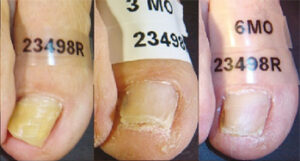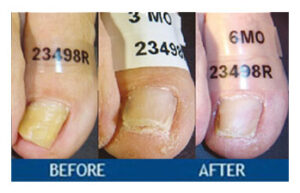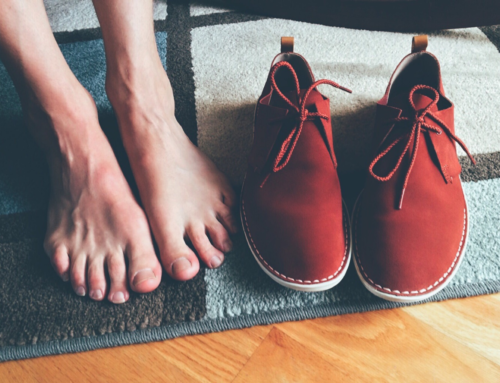At our clinics, we often consult people who are noticing odd changes in their nails and are wondering if it’s nail fungus. Nail fungus (medical name: onychomycosis) is quite common: it causes nearly half of all nail problems. It’s a fungal infection of the nail, usually starting at the tip or edge. Common signs include yellowing, thickening, and distortion of the nail. Below, we’ll cover how to spot nail fungus early and how it differs from other nail issues, so you can decide if it’s time to get checked.
What is Nail Fungus?
Nail fungus is a common infection of the fingernails or toenails. The fungi that cause it thrive in warm and damp places, like inside sweaty shoes or in public locker rooms. An infected nail often begins with a small discoloration under the nail tip. Over time, the fungus can grow deeper into the nail bed, and then the nail gradually thickens, discolors, and crumbles around the edges. In other words, the infection slowly disfigures the nail from the tip backward. Nail fungus isn’t usually painful at first, but it can eventually cause discomfort. This is especially true if the nail becomes very thick or lifts up.
Common Symptoms of Nail Fungus
You may notice these changes in one or more nails if fungus is present. The typical signs of nail fungus include:
- Discoloration: Nails often turn yellowish, whitish, or even brown. The change may start as a spot or streak and then spread. Over time, it can enlarge across the nail.
- Thickening and Brittle Texture: The nail often thickens unevenly and becomes hard to trim. It can feel gritty or rough. Nails may become brittle, crumbly, or ragged along the edges. You might notice bits flaking off when you trim them.
- Mishapen or Lifting Nail: Infected nails can become distorted in shape. They may even bulge or curl. The nail plate can lift up from the nail bed (this is called onycholysis). When a nail lifts, a white layer of debris may collect under it.
- Odor: Sometimes a mild foul smell comes from the affected nails, especially if it’s been infected for a while. This is a less common sign, but if you do notice an odor, it’s likely fungal.
If you’re seeing thick, yellow nails that are growing out unevenly or splintering, it’s worth investigating at one of our clinics; these are classic fungal infection symptoms. Catching it early, when you first notice a tiny change, makes treatment dramatically easier.
How Is It Different From Other Nail Conditions?
Not all nail changes are due to fungus. Here are some key differences to help you tell them apart:
- Nail injury vs. nail fungus: If you injured your nail (stubbed your toe or dropped something on it), you might see a black, blue, or red bruise under the nail. This trauma mark usually doesn’t smell and will not spread to other nails. Over time, the bruise grows out as the nail grows. In contrast, a nail infected with fungus tends to be yellow or white and spread. These infected nails may even have a slight odor.
- Nail psoriasis vs. fungus: Nail psoriasis (an autoimmune condition) can look a lot like fungus, but there are clues. Nail psoriasis symptoms often display themselves as tiny pits (little dents) on the surface and sometimes “oil-drop” spots (reddish-brown patches) under the nail. Also, psoriasis usually appears on fingernails alongside other skin symptoms (like scaly patches on elbows or knees). In the case of fungus, you won’t see those pits or oil spots. These types of nails typically yellow and thicken without the red “lipstick line” that psoriasis can cause around a lifted nail. Another tip: fungus, more often than not, affects the toenails, especially one at a time. In comparison, psoriasis commonly attacks the fingernails and usually multiple nails at a time.
- Other infections or conditions: Certain problems, like bacterial infection or nutritional deficiencies, can affect nails; however, they also have distinguishing signs. For example, if your nails are unusually soft or peeling but without discoloration, it might just be due to dry nails or chemical damage. Athlete’s foot (a type of skin fungus between toes) is commonly linked to toenail fungus. If you have a bad case of athlete’s foot along with nail changes, that’s a strong hint that the nail issues are fungal. Always consider the overall picture: fungal nails often come with a history of foot fungus, while other nail problems usually have a specific cause (injury, eczema, etc.).


Early Warning Signs to Look Out For
One key to dealing with nail fungus is early detection. Often, people first see something subtle, maybe a tiny white or yellow spot on the corner of the nail. At this stage, you might not feel any pain, but the nail may soon start to feel slightly thicker or rough. Keep an eye on it for any other changes. Here are some other early red flags:
- New streak or spot: Even a small discoloration (yellow, white, or light brown) could be an early fungal patch.
- Texture changes: A healthy nail is smooth and transparent. If you begin to notice ridges, dullness, or a rough patch, it might be developing fungus.
- Gradual progression: Fungal nails usually get worse over time. If the problem area is getting bigger or affecting more of the nail each month, it’s likely an infection spreading. By contrast, a bruise or small injury typically improves as the nail grows.
Because fungus can be stubborn, catching it early makes treatment more effective. Noticing a slight color change or thickness early means you can prevent the spread of the infection and save your nail.
Laser Therapy for Nail Fungus
If a nail fungus diagnosis is confirmed, you have treatment options. At our clinic, we use the PinPointe® FootLaser. The PinPointe® FootLaser is the most advanced, safe, and highest-cure-rate treatment on the market. This makes it the premier drug-free way to kill nail fungus. In this treatment, laser energy is applied briefly to each affected nail, heating and destroying the fungal cells while having minimal impact on healthy skin. Studies show laser treatments are effective and safe in 85% of cases. Side effects are generally negligible (some people feel a bit of warmth or tenderness during treatment), and you can resume regular daily activities right afterwards. The key advantage of using laser therapy is that it directly reaches under the nail, whereas topical creams often can’t penetrate fully. Oral medications can take a long time to work and have risks of reinfection as high as 20%. These drugs can also interfere with other prescription medications, among other side effects, such as rashes or, in severe cases, liver disease and gastrointestinal damage.
Our team will discuss whether treatment with the PinPointe® FootLaser is right for you. The important thing is not to wait: early treatment improves the chances of getting rid of the infection for good.


Free Consultation and What to Do Next
If you’ve read this far and recognize some of these signs on one or more of your nails, don’t hesitate to reach out. We offer free consultations at each of our clinics to help you figure out what’s going on with your nails – no obligation, just honest advice. During a consultation with one of our medical doctors at over 160 medical clinics across the United States, we can examine your nails to confirm whether it’s fungus or something else. Early diagnosis means faster, easier treatment and better results.
To schedule your free consultation or just ask any questions, contact us today at (800) 672-0625. We are ready to help you. Once you call, we’ll explain your options and put your mind at ease. Remember, if you do have nail fungus, treating it sooner keeps it from spreading and returning. Your journey toward healthy nails starts here, and we’re ready to help you every step of the way.





